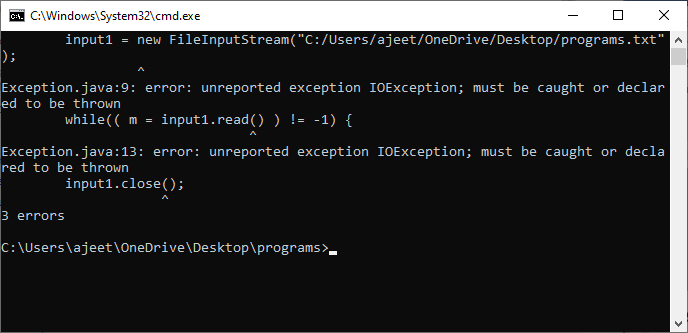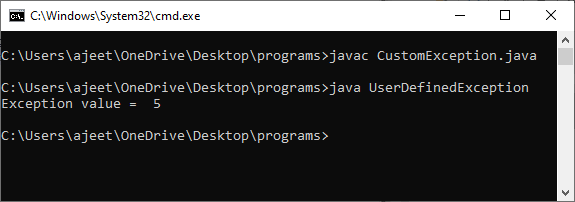Types of Exception in JavaIn Java, exception is an event that occurs during the execution of a program and disrupts the normal flow of the program's instructions. Bugs or errors that we don't want and restrict our program's normal execution of code are referred to as exceptions. In this section, we will focus on the types of exceptions in Java and the differences between the two. Exceptions can be categorized into two ways:

Built-in ExceptionExceptions that are already available in Java libraries are referred to as built-in exception. These exceptions are able to define the error situation so that we can understand the reason of getting this error. It can be categorized into two broad categories, i.e., checked exceptions and unchecked exception. Checked ExceptionChecked exceptions are called compile-time exceptions because these exceptions are checked at compile-time by the compiler. The compiler ensures whether the programmer handles the exception or not. The programmer should have to handle the exception; otherwise, the system has shown a compilation error. CheckedExceptionExample.java In the above code, we are trying to read the Hello.txt file and display its data or content on the screen. The program throws the following exceptions:
Output: 
How to resolve the error?There are basically two ways through which we can solve these errors. 1) The exceptions occur in the main method. We can get rid from these compilation errors by declaring the exception in the main method using the throws We only declare the IOException, not FileNotFoundException, because of the child-parent relationship. The IOException class is the parent class of FileNotFoundException, so this exception will automatically cover by IOException. We will declare the exception in the following way: If we compile and run the code, the errors will disappear, and we will see the data of the file. 
2) We can also handle these exception using try-catch However, the way which we have used above is not correct. We have to a give meaningful message for each exception type. By doing that it would be easy to understand the error. We will use the try-catch block in the following way: Exception.java We will see a proper error message "File Not Found!" on the console because there is no such file in that location. 
Unchecked ExceptionsThe unchecked exceptions are just opposite to the checked exceptions. The compiler will not check these exceptions at compile time. In simple words, if a program throws an unchecked exception, and even if we didn't handle or declare it, the program would not give a compilation error. Usually, it occurs when the user provides bad data during the interaction with the program. Note: The RuntimeException class is able to resolve all the unchecked exceptions because of the child-parent relationship.UncheckedExceptionExample1.java In the above program, we have divided 35 by 0. The code would be compiled successfully, but it will throw an ArithmeticException error at runtime. On dividing a number by 0 throws the divide by zero exception that is a uncheck exception. Output: 
UncheckedException1.java Output: 
In the above code, we are trying to get the element located at position 7, but the length of the array is 6. The code compiles successfully, but throws the ArrayIndexOutOfBoundsException at runtime. User-defined ExceptionIn Java, we already have some built-in exception classes like ArrayIndexOutOfBoundsException, NullPointerException, and ArithmeticException. These exceptions are restricted to trigger on some predefined conditions. In Java, we can write our own exception class by extends the Exception class. We can throw our own exception on a particular condition using the throw keyword. For creating a user-defined exception, we should have basic knowledge of the try-catch block and throw keyword. Let's write a Java program and create user-defined exception. UserDefinedException.java Output: 
Description: In the above code, we have created two classes, i.e., UserDefinedException and NewException. The UserDefinedException has our main method, and the NewException class is our user-defined exception class, which extends exception. In the NewException class, we create a variable x of type integer and assign a value to it in the constructor. After assigning a value to that variable, we return the exception message. In the UserDefinedException class, we have added a try-catch block. In the try section, we throw the exception, i.e., NewException and pass an integer to it. The value will be passed to the NewException class and return a message. We catch that message in the catch block and show it on the screen. Difference Between Checked and Unchecked Exception
Bugs or errors that we don't want and restrict the normal execution of the programs are referred to as exceptions. ArithmeticException, ArrayIndexOutOfBoundExceptions, ClassNotFoundExceptions etc. are come in the category of Built-in Exception. Sometimes, the built-in exceptions are not sufficient to explain or describe certain situations. For describing these situations, we have to create our own exceptions by creating an exception class as a subclass of the Exception class. These types of exceptions come in the category of User-Defined Exception.
Next TopicWhy String is Immutable or Final in Java
|
 For Videos Join Our Youtube Channel: Join Now
For Videos Join Our Youtube Channel: Join Now
Feedback
- Send your Feedback to [email protected]
Help Others, Please Share










